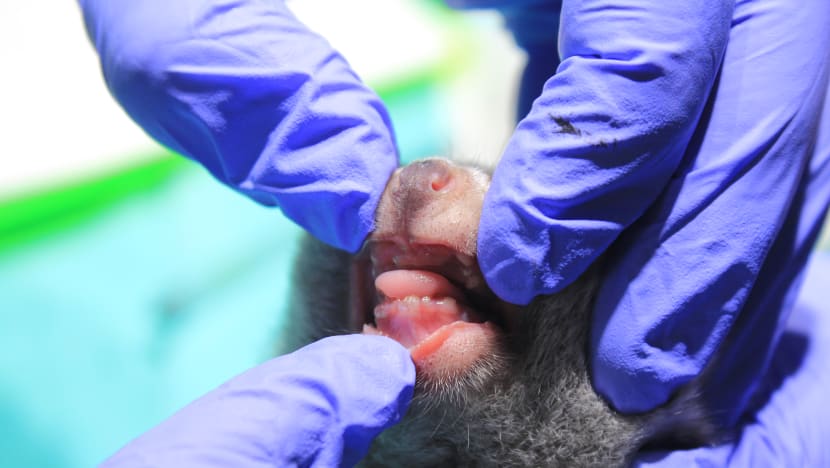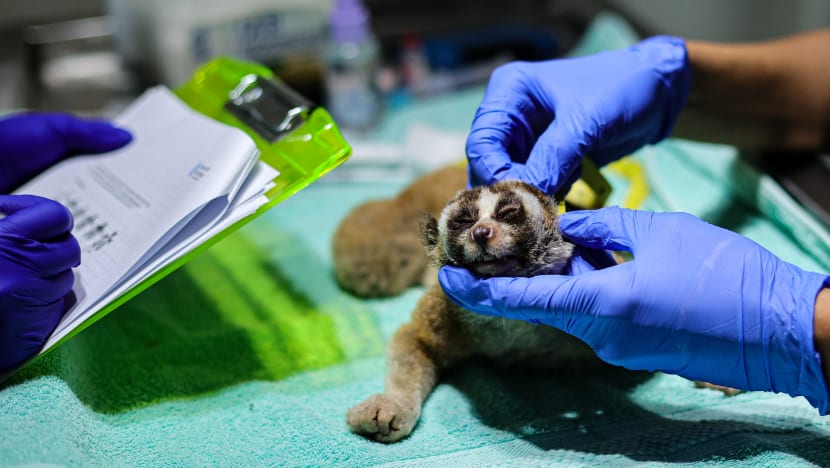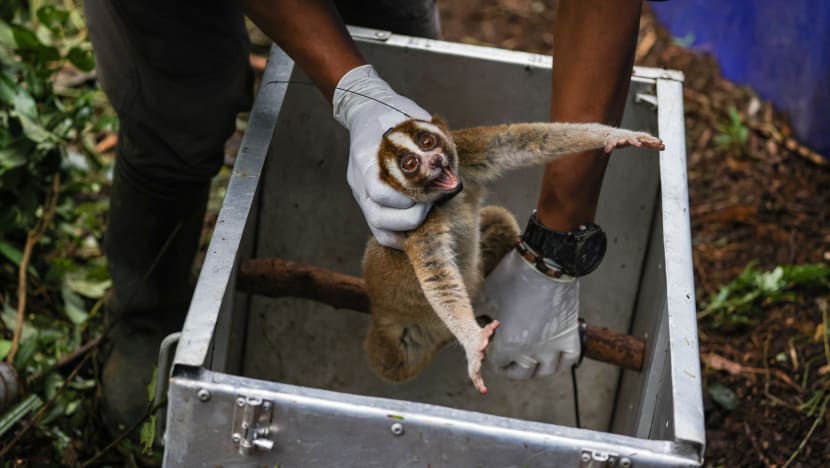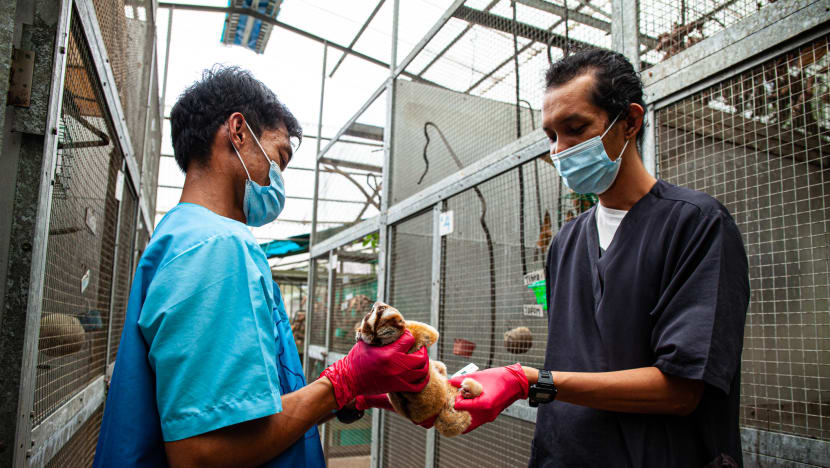Rescuers of endangered slow loris in Indonesia not resting on their laurels, despite drop in smuggling

A critically endangered Javan slow loris holding on to a tree branch in West Java, Indonesia, after being reintroduced into the wild. (Photo courtesy of International Animal Rescue)
JAKARTA: With big puppy eyes, fluffy fur, a seemingly placid demeanour and a size no bigger than a grapefruit, slow lorises have been traded illegally online, sold at bird markets in big cities like Jakarta or smuggled overseas.
Buyers might be drawn to their cuteness but members of the slow loris genus, several species of which are critically endangered including the Javan slow loris, are no pets.
Slow lorises are the world’s only venomous primates. They have glands underneath their armpits that ooze hazardous oil which when mixed with the lorises’ saliva produces a venom powerful enough to rot flesh.
When threatened, lorises curl their body to lick the glands before delivering a bite so strong and grisly that their grooved canines can pierce through bone. If bitten, humans can have days of high fever, swelling and in rare cases even die.
This is why poachers sometimes file slow lorises’ teeth or remove them completely before selling them as pets.
“Some (lorises) had the tips of their canines clipped. There are those whose teeth are ground right down to the edge of their gums. Some had all of their teeth extracted completely,” Wendi Prameswari, a veterinarian who has been working on rehabilitating slow lorises rescued from the hands of wildlife poachers for the past 10 years, told CNA.
“You can imagine how painful it must have been for them.”

Prameswari said out of the 130 lorises at the International Animal Rescue (IAR) rehabilitation facility in Bogor where she works, 100 have had their teeth removed. “They will have to spend the rest of their lives at a sanctuary. They can never be released into the wild because they cannot defend themselves,” she said.
Despite numerous arrests of sellers and buyers as well as a relentless campaign to stop the trade, demand for slow loris seems to still exist, as evidenced by the many social media posts of people with their pet Javan slow lorises in Indonesia and abroad.
“In Indonesia, slow lorises are not only sold as pets. In Sumatra, they are sometimes slaughtered as offerings in a dark magic ritual to cast evil spells on others. In other parts of the country, some people killed lorises for their oil which they believe can act as a love potion,” Ode Kalashnikov, IAR’s wildlife protection unit manager, told CNA.
Related:
Poaching has been one of the main reasons for slow lorises’ sharp population decrease, along with habitat loss, the International Union for Conservation of Nature (IUCN) noted.
The population for the Javan slow loris, for example, has seen a decline of over 80 per cent over the last 24 years, said the organisation. It is now considered critically endangered by the IUCN.
DIRE CONDITIONS
Prameswari estimated that between 5 and 20 per cent of slow lorises died once they were in the hands of poachers.
“It depends on how fast we intervene,” she said. “There had been cases where law enforcers were able to rescue these animals within weeks after they were captured. But there were times when slow lorises spent months in captivity.”
The veterinarian said poachers typically held slow lorises in small cages once they were captured from the wild or placed in plastic fruit crates when they were smuggled across provincial or national borders.“The creature is mostly solitary in the wild and can be very territorial,” she said. “This is why slow lorises can get embroiled in fights over territory and food.”

The fights could be so nasty that slow lorises sometimes got permanently injured and even died, particularly in captivity where such brawls occurred more frequently.
“Whenever we rescued slow lorises from poachers, between 10 and 20 per cent of them required immediate medical attention. In fact, some lorises were already dead by the time we found them,” she said, adding that these lorises either died from fights or malnutrition because other lorises took their food.
Even if the lorises survived, the injuries they sustained could be severe. Prameswari said she had seen slow lorises with chunks of their skin and flesh missing, sometimes leaving the bones exposed. To make matters worse, it takes a long time for slow lorises to recover from their injuries.
Life in captivity, where the threat of attack from other slow lorises were constantly lurking, could be stressful and traumatising for some slow lorises that they sometimes nibbled on their own flesh, the veterinarian continued.

The injuries these nocturnal primates sustained were not exclusively from fights with other lorises. The rehabilitation centre has had a number of lorises which had gunshot wounds, and even metal air gun pellets lodged inside their stomachs and skulls.
“We also had lorises which were electrocuted because they ventured into residential areas and swung on aerial electricity cables,” Prameswari said.
POACHING STILL HAPPENING
Years of campaigning had done a lot to slow down the trade of slow lorises in Indonesia. Today, most of the slow lorises cared for at the IAR rehabilitation centre are those found wandering into people’s neighbourhoods and farms.
Most of the primates rescued had severe injuries from fighting with other lorises.
“Slow lorises which came from raids and confiscation are becoming rarer and rarer,” Prameswari said.

Kalashnikov said it is now hard to find slow lorises openly traded at markets and online. “People are now aware that slow lorises are protected species and they can go to jail if they buy or keep them,” he said.
“Things were very different back in 2015 when we could encounter dozens of slow lorises being sold every week at a given market. Since then, law enforcers began to pay more attention to the trade and conducted raids and arrests.”

Organisations have also worked with social media and online marketplace companies to ensure that posts soliciting and selling protected wildlife are taken down.
But that does not mean that the trade has disappeared.
After more than a year of no major arrests and raids, police foiled the smuggling of 79 Javan slow lorises in January 2019. The lorises were being transported from West Java province, where they were captured, to an international port in East Java where they would be smuggled to China.
“Just when we thought we had seen a significant drop in the trade of slow lorises, this case occurred,” Kalashnikov said.
The IAR manager said it was not clear whether the case was a one-off shipment or part of an ongoing operation which had been around for years.
“Unfortunately, only the low-level players were caught while the brains behind the operation remained hidden,” he said.

Kalashnikov said although slow lorises could fetch a price of no more than 500,000 rupiah (US$35) in Indonesia, overseas they could be sold as lofty as US$3,000, making it a very lucrative trade.
There had been several small arrests since – the latest occurred in July when two people were arrested in Riau province for trying to sell eight Sumatran slow lorises.
National police spokesman Ahmad Ramadhan said the low number of arrests did not mean that the slow loris trade had truly declined, adding that poachers might have simply gotten better at hiding their operations.
"We have been conducting regular inspections at bird markets and places where traditionally protected species are traded. We have also been conducting cyber patrols to look for sellers and buyers online. These force poachers to go underground and operate in secret," he told CNA.
"But wildlife trade in general is still pretty lucrative and remains a big problem. Perhaps demand for slow lorises slows down for now and the trend has moved towards other protected species. But it doesn't mean that (slow lorises) won't be in demand again."
Kalashnikov said it is important for environmental groups and law enforcers not to rest on their laurels.
“We were patting ourselves on the back, we were confident that no one was trading (slow lorises) and we let our guards down. But then the 2019 case made us realise that this is not over,” he said.
“We have to remain vigilant. We have to keep campaigning against wildlife trade."















